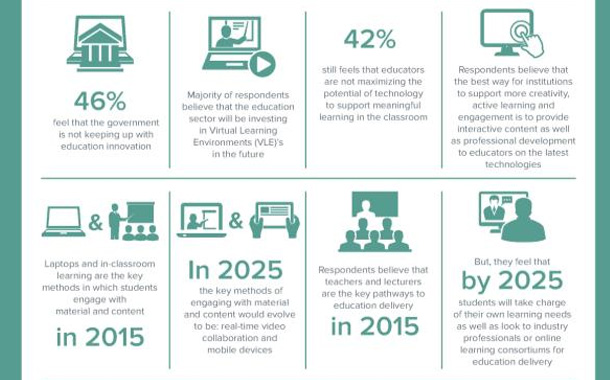Survey finds technology will shift from laptops and in-classroom learning to video collaboration and mobile to engage with educational content by 2025
Academic institutions are more likely to invest in Virtual Learning Environments (VLEs) to improve education delivery in the future. Additionally, classrooms will eventually make way for real-time video collaboration and mobile devices for interactive student-tailored lessons, according to findings in an ‘Education in 2025 – Technology Innovation’ survey report by Polycom.
As per the report, over 1,800 people globally from a diverse range of job roles within the education sector participated in the survey that focused on the requirements for education by 2025. Views from Asia Pacific were derived mainly from respondents in Australia and New Zealand (ANZ) and from India.
The three main factors which appeared to be inhibiting the progression of the education landscape were found to be: funding, government not keeping pace with technological advancements, and curriculum not aligned to future workforce needs.
Further, almost 42% of respondents from Asia Pacific (43% in India and 40% in Australia and New Zealand) believed that parents and students alike are demanding more access to content and lectures online. The respondents believed technology has an important role to play to support creativity, active learning and engagement as well as increase collaboration between schools and corporations and define career pathways (partnerships, virtual internships, and e-mentoring). However respondents also felt its potential is not being maximized, citing both teacher professional training and current learning models as an issue.
According to the press release, the most prevalent concerns among respondents from Asia Pacific are accessibility of education, student engagement, and preparedness for future jobs. In fact, the majority of respondents, 31% believe access to education for all who want to learn is more important than any other factor.
What was particularly interesting was that respondents from India have a different opinion from the rest of the world when it came to curriculum structure. Respondents from this region said that institutions should focus more on easy access to subject matter experts (25%) and peer supported learning and review (25%).
A significant majority of 58% in ANZ felt that the government is not keeping up with education innovation. In stark contrast, India came out as the most confident about the administration’s capabilities in ensuring progress in the education sector, with only 27% sharing the ANZ view. 62% from ANZ responded that technology would enable greater collaboration between schools and corporations.
Almost 42% (43% in India and 40% in ANZ) of those surveyed believed that parents and students alike are demanding more access to content and lectures online. When it came to technology, 41% (51% in ANZ and 31% in India) felt that its potential in supporting meaningful learning was not being maximized. In both India and ANZ, 17% felt that curriculum is not keeping pace with future workforce needs.
Looking to the future, a majority of Asia Pacific respondents were convinced that the education sector will likely invest in VLEs and cloud-based software platforms to facilitate teaching and learning delivery. Another key factor required for education in 2025 to be successful, was improving the quality of teacher-learning. Those in India (21%) also felt that the creation of a more personalised and contextual learning environment would be worth focusing on as well.
Elaine Shuck, Global Director, Education Solutions and Market Development at Polycom said, “Investing in such virtual environments would support a wide range of tasks and workflows within educational environments providing clear advantages to students and teachers. These would include student assessments, collaboration tools, learning on-demand, links to dynamic content, and access to lesson plans and materials, opening up many more opportunities for educational delivery which may not have existed before. Technology is neither a replacement for teaching methods nor for teachers. Instead, it is the gateway to personalizing learning and providing a more collaborative approach to education for the future.”




